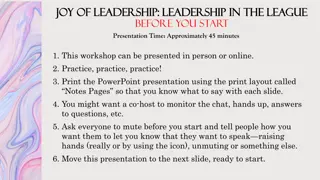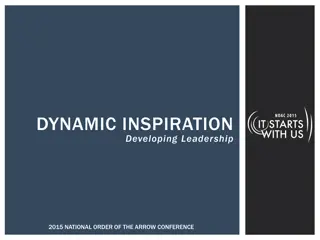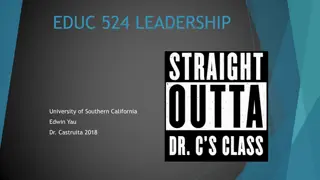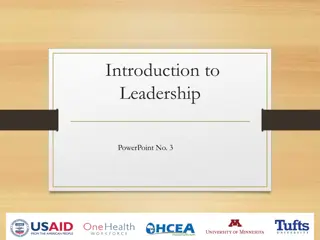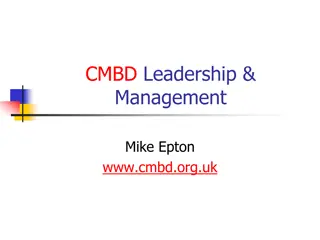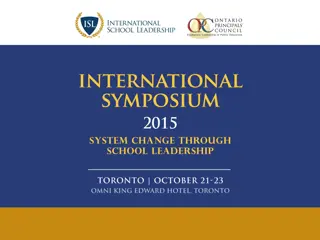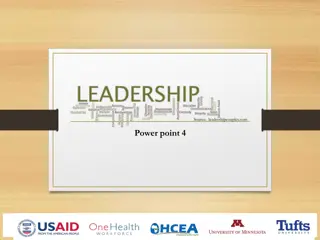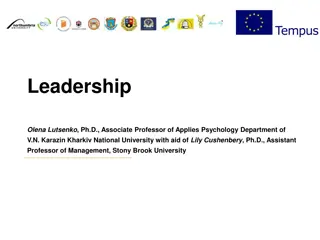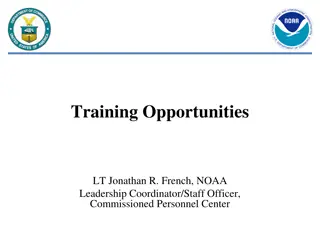
Leadership Theories, Styles, and Principles Explained in Detail
Explore the fundamentals of leadership, including key theories such as Great Man Theory and Trait Theory, common leadership styles like Autocratic and Democratic, and insights from renowned leaders such as John C. Maxwell and Peter Drucker. Understand the importance of influence, trust, and effective communication in successful leadership.
Download Presentation

Please find below an Image/Link to download the presentation.
The content on the website is provided AS IS for your information and personal use only. It may not be sold, licensed, or shared on other websites without obtaining consent from the author. If you encounter any issues during the download, it is possible that the publisher has removed the file from their server.
You are allowed to download the files provided on this website for personal or commercial use, subject to the condition that they are used lawfully. All files are the property of their respective owners.
The content on the website is provided AS IS for your information and personal use only. It may not be sold, licensed, or shared on other websites without obtaining consent from the author.
E N D
Presentation Transcript
FUNDAMENTAL OF LEADERSHIP Nur Rabbani Abdullah Senior Training Consultant Cluster for Leadership and Executive Development National Institute of Public Administration
Knowledge Skills Abilities HERO (psychology) LEADER VS. LEADERSHIP Influence Guide Motivate Network
Dictionary: Leadership = ability to lead: the ability to guide, direct, or influence people. John C. Maxwell: Real Leadership = being the person others will gladly and confidently follow. Leadership is influence nothing more, nothing less Donald G. Krause: Leadership can be defined as the will to control events, the understanding to chart a course, and the power to get a job done, cooperatively using the skills and abilities of other people Peter Drucker: Good leadership brings out the best in people and with it ordinary people could do extraordinary things Simon Sinek: To be a leader requires one thing and one thing only. Followers. That's it. Donald McGannon: Leadership is action, not position Dwight Eisenhower: Leadership is the art of getting someone else to do something you want done because he wants to do it
Great Man Theory 1840s by Thomas Carlyle Charisma, intelligence, wisdom Born to lead Traits Theory 1930-1940s by Gordon Allport Based on certain characteristics, mental, physical or social characteristics Trait State Personality Consistent Long lasting Temporary Depends on situation BORN VS. MADE Contingency Theories 1960s No single way of leading Fiedler s, Situational, Path-goal Transactional Theories 1970s Reward & punishment Leader member exchange Transformational Theories 1970s Inspiration Relationship & trust Charismatic Behavioral Theories 1940-1950s Task vs people The managerial grid model
3 COMMON LEADERSHIP STYLES Autocratic (Authoritarian) Democratic (Participative) Delegative Leader Leader Leader Employees Employees Employees EMPHASIS
Employee do not respond to any other leadership style Work needs to be coordinated with other a number of parties The area was poorly managed The leader wants to keep employees informed about matters that effect them The leader want employees to share in decision-making and problem-solving duties You want to encourage team building and participation Employees are highly skilled, experienced and educated Employees have pride in their work and the drive to do it successfully on their own Employees are trustworthy
LEADER VS. MANAGER

